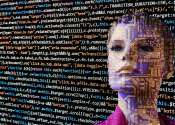Computer Sciences news
Computer Sciences
Exo 2: A new programming language for high-performance computing, with much less code
Many companies invest heavily in hiring talent to create the high-performance library code that underpins modern artificial intelligence systems. NVIDIA, for instance, developed some of the most advanced high-performance ...
Mar 13, 2025
0
68
Computer Sciences
Researchers develop innovative method for secure operations on encrypted data without decryption
A hospital that wants to use a cloud computing service to perform artificial intelligence data analysis on sensitive patient records needs a guarantee those data will remain private during computation. Homomorphic encryption ...
Mar 13, 2025
0
55

AI chatbots struggle with empathy: Overempathizing and gender bias uncovered
You can talk to an AI chatbot about pretty much anything, from help with daily tasks to the problems you may need to solve. Its answers reflect the human data that taught it how to act like a person; but how human-like are ...
Mar 5, 2025
0
8

AI pioneers who channeled 'hedonistic' machines win computer science's top prize
Teaching machines in the way that animal trainers mold the behavior of dogs or horses has been an important method for developing artificial intelligence and one that was recognized Wednesday with the top computer science ...
Mar 5, 2025
0
2

Researchers teach neural networks to add clouds and snow to images
Nikita Belyakov and Svetlana Illarionova, researchers from the Skoltech AI Center, presented a new method for semantic segmentation of multispectral data, which can be used to recognize clouds, shadows, and snow patches in ...
Mar 5, 2025
0
38
Consumer & Gadgets
Scientists study the hidden cost of Netflix's autoplay
Autoplay, a feature that automatically begins the next episode or movie without user input, has become a staple of modern streaming platforms like Netflix. But how much is this convenience truly costing us in terms of control ...
Mar 4, 2025
0
20
Computer Sciences

AI model mimics human goal-setting through game creation
While we are remarkably capable of generating our own goals, beginning with child's play and continuing into adulthood, we don't yet have computer models for understanding this human ability.
Feb 26, 2025
0
29
Computer Sciences

New study identifies differences between human and AI-generated text
A team of Carnegie Mellon University researchers set out to see how accurately large language models (LLMs) can match the style of text written by humans. Their findings were recently published in the Proceedings of the National ...
Feb 25, 2025
0
88
Computer Sciences

New report explores merging Web 3.0 with AI technologies
The Surrey Academy for Blockchain and Metaverse Applications (SABMA), a pioneering institution within the University of Surrey, is proud to announce the release of its groundbreaking report: Web 3.0 Protocol-as-Platform: ...
Feb 25, 2025
0
0
Computer Sciences

High-speed face tracking enhances augmented reality experiences
Augmented reality (AR) has become a hot topic in the entertainment, fashion, and makeup industries. Though a few different technologies exist in these fields, dynamic facial projection mapping (DFPM) is among the most sophisticated ...
Feb 20, 2025
0
43
Engineering

New technique aims to make food deliveries more efficient
North Carolina State University researchers have developed a new technique to improve the efficiency of food-delivery operations. The technique accounts for the location of food distribution sites and delivery locations to ...
Feb 20, 2025
0
0
Computer Sciences

Low-cost framework enhances metadata replication with adaptive synchronization
Metadata management has always been the focus of distributed file systems research. Metadata replication exhibits a comparative advantage in maintaining locality and balancing system load. However, according to the requirements ...
Feb 18, 2025
0
0
Software

Contextual analysis for recommending code reviewers
Code review is essential in software development, playing a vital role in enhancing product quality by catching mistakes early on. An integral part of this procedure is choosing the right reviewers to examine modifications ...
Feb 14, 2025
0
0
Computer Sciences

Computer graphics team makes advances in simulating ink diffusion
Calculating and visualizing a realistic trajectory of ink spreading through water has been a longstanding and enormous challenge for computer graphics and physics researchers.
Feb 13, 2025
0
25
Electronics & Semiconductors

Possible end of Moore's Law: Engineers discuss consequences and opportunities
In 1965, Gordon Moore defined a relationship between cadence and cost for computing innovation that came to be known as "Moore's Law." This rule both described and inspired the exponential growth that built the Information ...
Feb 12, 2025
0
1
Computer Sciences

New algorithm improves how AI can independently learn and uncover patterns in data
Researchers have developed a new AI algorithm, called Torque Clustering, that is much closer to natural intelligence than current methods. It significantly improves how AI systems learn and uncover patterns in data independently, ...
Feb 11, 2025
0
49
Computer Sciences

Interactive maps show quality of public transportation in Germany
How good is the public transportation from your home address? For an objective perspective, you can check the interactive "Mobility Maps" for Germany that are freely available online.
Feb 11, 2025
0
4
Computer Sciences

The era of practical quantum computers draws closer
In 1981, American physicist and Nobel Laureate, Richard Feynman, gave a lecture at the Massachusetts Institute of Technology (MIT) near Boston, in which he outlined a revolutionary idea. Feynman suggested that the strange ...
Feb 10, 2025
0
0
Computer Sciences

Cloud-based computing: Routes toward secure storage and affordable computation
Storing data in the cloud is now routine for people and companies alike, but cybersecurity risks still exist, particularly in handling user authentication and access control securely. Researchers are developing novel methods ...
Feb 10, 2025
0
2
Computer Sciences

Machine learning approach enhances emotion detection accuracy
Facial emotion recognition could have broad applications across health care, education, marketing, transportation, and entertainment. It might be used to help monitor patients remotely or in overstretched hospitals or emergency ...
Feb 7, 2025
0
0
Computer Sciences

Psychology-based tasks assess multi-modal LLM visual cognition limits
Over the past decades, computer scientists have created increasingly advanced artificial intelligence (AI) models, some of which can perform similarly to humans on specific tasks. The extent to which these models truly "think" ...
Hardware

Sustainable SOT-MRAM memory technology could replace cache memory in computer architecture in the future
How much energy is consumed each time we upload an image to social media, which relies on data centers and cloud storage? Data centers currently account for about 1% of global energy consumption, amounting to 200 terawatt-hours ...
Feb 6, 2025
0
37
Computer Sciences

Improving domain-specific languages to save time on hybrid particle filtering
A particular set of probabilistic inference algorithms common in robotics involve Sequential Monte Carlo methods, also known as "particle filtering," which approximates using repeated random sampling. ("Particle," in this ...
Feb 6, 2025
0
10
Software

Software empowers users to select quantum program transpilers without being tied to a specific vendor
A research team at Osaka University and TIS Inc. has developed software "Tranqu" that allows users to select a transpiler that converts and optimizes quantum programs for execution on quantum chips. This enables users to ...
Feb 4, 2025
0
0







































